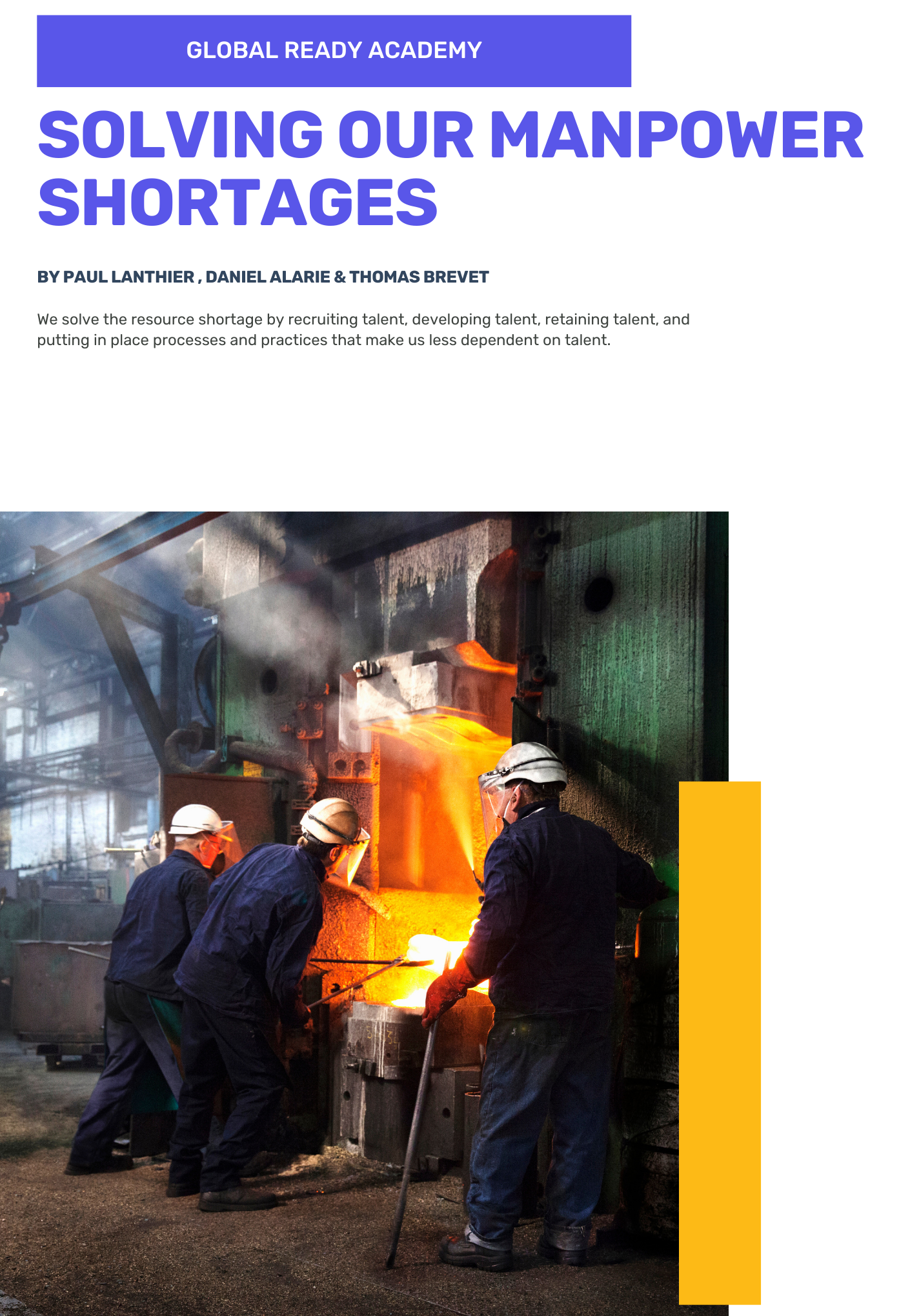Solving Our Manpower Shortages

What You'll Learn
Key strategies for overcoming manpower shortages through talent management and process optimization
- Recruitment: Leverage internal and external channels to attract the right talent.
- Talent Development: Use ongoing learning and coaching to boost employee skills.
- Retention: Create an engaging environment aligned with employees’ goals.
- Process Improvement: Systematize tasks to reduce reliance on specific individuals.
- Financial Case: Develop an ROI-based business case for talent initiatives.
- Implementation: Apply these concepts for sustainable, long-term success.
Introduction
Dofasco, a Canadian steel company, used to say: “Our product is steel, our strength is people”. Experience shows that without a competent and motivated staff our production lines stop more often, they are slower to restart, they break down more often, we consume more energy, our plant costs more to run and we have more quality losses. The result is higher production costs and lower profits, which runs counter to our business objectives.
In today’s world, where there is a shortage of skilled resources and staff turnover is on the rise, how do we solve this chronic shortage? We recruit talent, we develop it, we establish the organizational structure and culture needed to retain it, and we implement processes and practices that make us less dependent on talent.
“Our product is steel, our strength is people”
For the first approach- Recruiting talent is easier said than done, as these talented people also want to be compensated accordingly, sometimes beyond our salary structure. That’s why it’s important not only to have a strong internal recruitment department, but also to use the services of external HR professionals who can access a wider pool of candidates.
For the second approach- developing talent, this needs to be done through an effective skills assessment and training program. In other words, a program that is practical, applicable to our business and sustainable. Retaining talent is about creating an organization that engages the individual and responds to their goals and objectives. It’s a question of culture and an organizational structure that motivates people and engages them.
For the final approach-To be less dependent on talent, we need to develop fundamental internal practices and procedures that make us less dependent on setting the highest standards for incoming talent. These practices and procedures must also be easily transferable.
Recruiting Talent
We recommend that you use a professional recruitment agency to complement your in-house human resources department. As well as providing you with extra help, this organization can offer recruiters with specific knowledge of the positions you’re looking to fill, so they can find, and vet the right candidates before you get involved in the interview process. Professional recruitment organizations are well connected and are more accessible to people already working in your field (i.e., working for the competition).
Whoever oversees recruitment, to be successful and find the right candidates, they will need a well-developed and realistic job description. This is where we find that most organizations fail, as their job descriptions are generic and are not aligned with their business model (reference book: “A Practical Guide to Organizational Engineering”). In addition to the possibility of hiring the wrong person for the job, poor job descriptions create confusion as they tend to be too general, assign the same responsibilities to several roles, and omit crucial steps in the process. The result is an inefficient team and frustration for all. Your managers will also be frustrated, as vague roles and responsibilities are difficult to apply and enforce. In other words, if everyone is accountable for everything, no one is. In this type of work climate employees become disenchanted and are more likely to seek employment elsewhere.
Several years ago, we worked with a mine to help it develop the organization and programs needed to become proactive, using reliability principles. This included defining and implementing a best-in-class asset management business process and job descriptions. When asked what this has meant for him, the Mobile Fleet Superintendent replied:
“Up until a year and a half ago, I would get calls every night at home [to resolve a problem]. Today, I no longer receive phone calls. In other words, we are now in control. To be in control, we must follow a process, and our job descriptions must be aligned with that process.”
“Up until a year and a half ago, I would get calls every night at home [to resolve a problem]. Today, I no longer receive phone calls. In other words, we are now in control. To be in control, we must follow a process, and our job descriptions must be aligned with that process.”
Becoming Less Dependent on Talent

This can be achieved by defining, implementing, and communicating good business processes (Reference books: “A Practical Guide to Organizational Engineering” and “Guide to Assessing Your Asset Performance Management Practices and Developing an Improvement Plan”), and by establishing simple-to-use fundamentals such as procedures and work instructions. The key words are “simple to use”. In a plant, these include standard operating procedures (SOPs), work instructions, preventive maintenance programs (PMs), standard jobs, one-minute lessons, etc. Each document/instruction must be written in easy-to-understand language, with a minimum of words. Wherever possible, photos and drawings are used to help communicate what is required. The idea is to write in a way that a grade 6 pupil can understand. This is what we call “systematization”: the development of the systems and practices needed to operate and maintain your plant. We can go further and include simplified, easy-to-transfer tools for every role within the organization. Higher functions will need more details, and documents will be more complex, but they will always remain as simple as possible.
The mine we mentioned earlier is a perfect example. The mine site is in a remote area and, more than 20 years ago, was only accessible by train and plane. It’s in the far north, and the winters are very long. This situation led to a staff turnover rate of over 30% per year. We have estimated that it takes at least one year for a new operator to become independent, and two to three years for a technician (many feel that it takes four years for a technician to become independent). The ramp-up time for management positions varies, but they generally take at least two years to become self-sufficient. Due to the high turnover rate, the people training the new employees were not fully trained themselves. The site referred to this situation as “babies training babies”. We launched a systematization project in which EVERYTHING was documented and simplified. Our goal was to be able to fully integrate a new resource within a year. We exceeded this target, as most people were self-sufficient after 6 months, and all within a year.
Read the rest
Download the rest of the white paper and learn:
How to develop and implement simple, transferable procedures that make your organization more resilient.
- Methods to calculate the return on investment (ROI) from reduced ramp-up times, decreased rework, and operational efficiencies.
The practical impact of these strategies, including reduced employee turnover and increased equipment lifespan.





